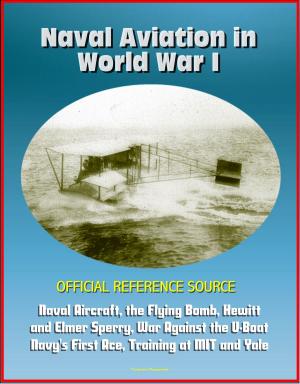Joint by Design: The Western Desert Campaign – World War II Allied Victory in North Africa Against the Desert Fox Rommel, Battle at El Alamein, Role of the Army Air Force, Attacking Enemy as a System
Nonfiction, History, Military, United States, World War II| Author: | Progressive Management | ISBN: | 9781370862740 |
| Publisher: | Progressive Management | Publication: | February 14, 2017 |
| Imprint: | Smashwords Edition | Language: | English |
| Author: | Progressive Management |
| ISBN: | 9781370862740 |
| Publisher: | Progressive Management |
| Publication: | February 14, 2017 |
| Imprint: | Smashwords Edition |
| Language: | English |
This excellent report has been professionally converted for accurate flowing-text e-book format reproduction. During the Second World War, the Allied Forces were victorious in the Western Desert Campaign not because of heroic individual leadership, but because improvements in command relationships, basing, and resource allocation enabled them to fight effectively as a joint and coalition force. Air and land commanders used co-located headquarters and liaison officers to overcome significant philosophical differences in the structure of the British versus American chains of command. Air forces developed a technique to move operations to a new aerodrome quickly, enhancing flexibility and reach. Finally, the Allied forces applied a systems approach to shock and overwhelm the enemy, attacking it with a combination of American bomber aircraft and improved close air support tactics.
Today's military should emulate the way the Allies allocated their resources in North Africa. Rather than focusing exclusively on a single perceived decisive node or parceling air support to ground commanders at the lowest echelons, planners should attack the enemy as a system. In an era of reduced military spending, the United States cannot count on an ability to mass resources and "win" with brute force alone. Like the Allied forces in North Africa, America may again find itself under-resourced in a fight against a near-peer competitor. Success will lie in effectively using every available tool to understand the situation and then act in multiple ways to shock the enemy's system—out thinking the adversary when out-numbering or out-spending is impossible.
In the early stages of the Second World War, North Africa was strategically important. Following early German successes in Europe, Benito Mussolini declared war on France and Britain in June 1940. In a clash of empires, Mussolini's goal was to force the British out of Egypt, claim the Suez Canal, and thus control access to crucial oil supplies in the Middle East. Simultaneously the Italians attacked British Imperial forces in Sudan, Kenya, and British Somaliland, but to no avail. The British forced Italy out of Ethiopia, Italian Somaliland, British Somaliland, and Eritrea, and the Italian army in East Africa surrendered on May 19, 1941. Meanwhile, Italian forces in Libya invaded Egypt in September 1940. In December, British forces counterattacked and soundly defeated the Italians in February 1941. Unwilling to let Mussolini's military defeat become a political victory for the Allies, Adolf Hitler dispatched two Panzer divisions to Libya, known as the Afrika Korps, putting Rommel in command. Rommel launched a counter-attack in March that surprised the British and forced them to withdraw to the east along the North African coast. For the next fourteen months, battles "were to ebb and flow eastwards and westwards across the Western Desert." After a significant Axis victory in June, the British forces retreated east to a defensive line at the small coastal town of El Alamein, the last defendable point before Alexandria and the Suez Canal. The Eighth Army fortified its position with minefields and wire along the forty-mile stretch of desert between the Mediterranean Sea to the north and the impassable Qattara Depression to the south. British General Claude Auchinleck, commander of ground forces in the Western Desert, took over the duties of field commander during the retreat. The strategic implications of the stalemate in the Western Desert had far-reaching effects in terms of morale, resolve, and world opinion. The public saw that despite "numerically stronger forces," the British "had failed to defeat the Axis." In fact, "British prestige in the Middle East sank to a new depth when it began to look as if, despite American lend-lease equipment which was being sent in an ever-increasing stream, the Suez Canal would be lost to the Allied cause."
This excellent report has been professionally converted for accurate flowing-text e-book format reproduction. During the Second World War, the Allied Forces were victorious in the Western Desert Campaign not because of heroic individual leadership, but because improvements in command relationships, basing, and resource allocation enabled them to fight effectively as a joint and coalition force. Air and land commanders used co-located headquarters and liaison officers to overcome significant philosophical differences in the structure of the British versus American chains of command. Air forces developed a technique to move operations to a new aerodrome quickly, enhancing flexibility and reach. Finally, the Allied forces applied a systems approach to shock and overwhelm the enemy, attacking it with a combination of American bomber aircraft and improved close air support tactics.
Today's military should emulate the way the Allies allocated their resources in North Africa. Rather than focusing exclusively on a single perceived decisive node or parceling air support to ground commanders at the lowest echelons, planners should attack the enemy as a system. In an era of reduced military spending, the United States cannot count on an ability to mass resources and "win" with brute force alone. Like the Allied forces in North Africa, America may again find itself under-resourced in a fight against a near-peer competitor. Success will lie in effectively using every available tool to understand the situation and then act in multiple ways to shock the enemy's system—out thinking the adversary when out-numbering or out-spending is impossible.
In the early stages of the Second World War, North Africa was strategically important. Following early German successes in Europe, Benito Mussolini declared war on France and Britain in June 1940. In a clash of empires, Mussolini's goal was to force the British out of Egypt, claim the Suez Canal, and thus control access to crucial oil supplies in the Middle East. Simultaneously the Italians attacked British Imperial forces in Sudan, Kenya, and British Somaliland, but to no avail. The British forced Italy out of Ethiopia, Italian Somaliland, British Somaliland, and Eritrea, and the Italian army in East Africa surrendered on May 19, 1941. Meanwhile, Italian forces in Libya invaded Egypt in September 1940. In December, British forces counterattacked and soundly defeated the Italians in February 1941. Unwilling to let Mussolini's military defeat become a political victory for the Allies, Adolf Hitler dispatched two Panzer divisions to Libya, known as the Afrika Korps, putting Rommel in command. Rommel launched a counter-attack in March that surprised the British and forced them to withdraw to the east along the North African coast. For the next fourteen months, battles "were to ebb and flow eastwards and westwards across the Western Desert." After a significant Axis victory in June, the British forces retreated east to a defensive line at the small coastal town of El Alamein, the last defendable point before Alexandria and the Suez Canal. The Eighth Army fortified its position with minefields and wire along the forty-mile stretch of desert between the Mediterranean Sea to the north and the impassable Qattara Depression to the south. British General Claude Auchinleck, commander of ground forces in the Western Desert, took over the duties of field commander during the retreat. The strategic implications of the stalemate in the Western Desert had far-reaching effects in terms of morale, resolve, and world opinion. The public saw that despite "numerically stronger forces," the British "had failed to defeat the Axis." In fact, "British prestige in the Middle East sank to a new depth when it began to look as if, despite American lend-lease equipment which was being sent in an ever-increasing stream, the Suez Canal would be lost to the Allied cause."















